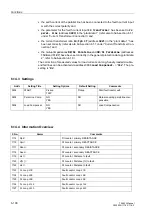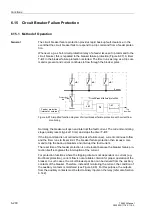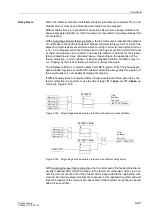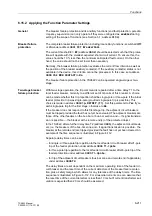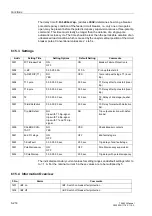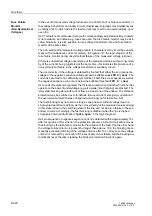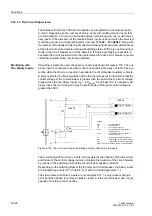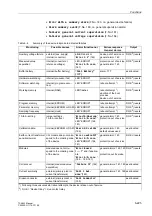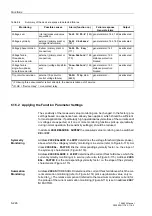
Functions
6-211
7SA522 Manual
C53000-G1176-C119-2
6.15.2 Applying the Function Parameter Settings
General
The breaker failure protection and its ancillary functions (end fault protection, pole dis-
crepancy supervision) can only operate if they were configured as
HQDEOHG
during
setting of the scope of functions (see Section 5.1, address
).
Breaker failure
protection
The complete breaker failure protection including its ancillary functions is switched
Off
or
On
under address
The current threshold
(address
) should be selected such that the protec-
tion will operate with the smallest expected short-circuit current. To ensure this, the
value should be 10 % less than the minimum anticipated fault current. On the other
hand, the value should not be set lower than necessary.
Normally, the breaker failure protection evaluates the current flow criterion as well as
the position of the breaker auxiliary contact(s). If the auxiliary contact(s) status is not
available in the device, this criterion cannot be processed. In this case, set address
1R
.
The breaker failure protection in the 7SA522 can be operated single-stage or two-
stage:
Two-stage breaker
failure protection
With two-stage operation, the trip command is repeated after a time delay T1 to the
local feeder breaker, normally to a different set of trip coils of this breaker. A choice
can be made whether this trip repetition shall be single-pole or three-pole if the initial
feeder protection trip was single-pole (provided single-pole trip is possible). This
choice is made in address
. Set this parameter to
<HV
if you
wish single-pole trip for the first stage, otherwise to
1R
.
If the breaker does not respond to this first stage trip, the adjacent circuit breakers
must be tripped provided the fault has not yet been cleared. The adjacent breakers are
those of the other feeders on the bus-bar or bus-bar section and — if signal transmis-
sion is possible — the breaker at the remote end(s) of the protected object.
In the 7SA522, after a further delay time T2 (address
), the adjacent circuit break-
ers (i.e. the breakers of the bus-bar zone and - if signal transmission is possible - the
breaker at the remote end) are tripped provided the fault has not yet been cleared. An
example of the time sequence is illustrated in Figure 6-112.
Separate delay times can be set:
−
for single- or three-pole trip repetition to the local feeder circuit breaker after 1-pole
trip of the feeder protection under address
−
for three-pole trip repetition to the local feeder circuit breaker after 3-pole trip of the
feeder protection under address
,
−
for trip of the adjacent circuit breakers (bus-bar zone and remote end if applicable)
under address
The delay times are set dependant on the maximum operating time of the feeder cir-
cuit breaker and the reset time of the current detectors of the breaker failure protec-
tion, plus a safety margin which allows for any tolerance of the delay timers. The time
sequence is illustrated in Figure 6-112. For sinusoidal currents one can assume that
the reset time of the current detectors is less than 10 ms but if current transformer sat-
uration is expected then 20 ms should be assumed.
Summary of Contents for siprotec 7SA522
Page 20: ...7SA522 Manual C53000 G1176 C119 2 ...
Page 64: ...7SA522 Manual C53000 G1176 C119 2 ...
Page 89: ...SIPROTEC 4 Devices 4 25 7SA522 Manual C53000 G1176 C119 2 Figure 4 20 CFC Logic example ...
Page 408: ...7SA522 Manual C53000 G1176 C119 2 ...
Page 456: ...7SA522 Manual C53000 G1176 C119 2 ...
Page 516: ...7SA522 Manual C53000 G1176 C119 2 ...
Page 620: ...Appendix B 48 ...


